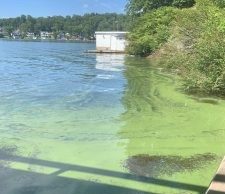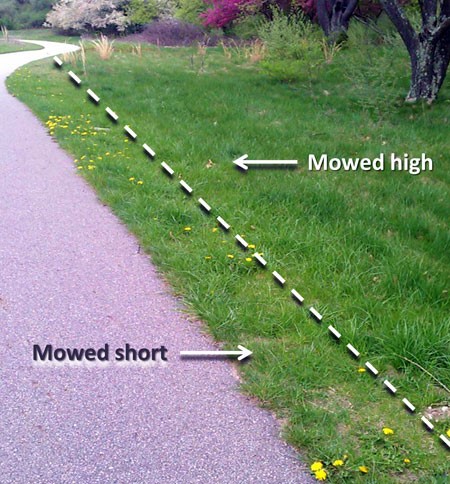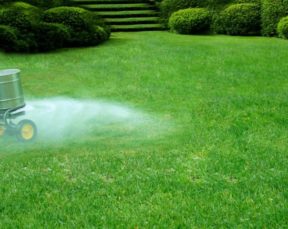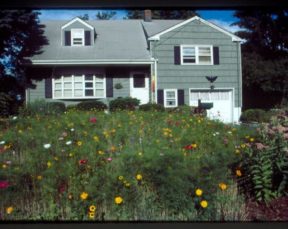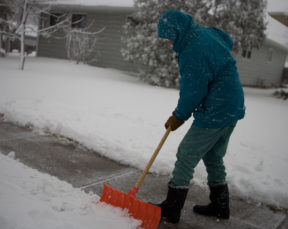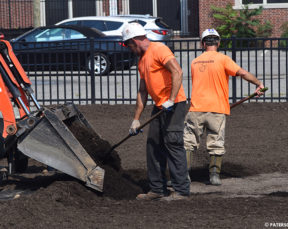It’s not easy being in quarantine while the weather warms and flowers bloom. Many of us are beginning to work on our gardens and lawns. What better way to spend this enforced home time during quarantine than to create an ecofriendly yard? Wouldn’t it feel great to maintain your lawn but also know you’re doing it in a way that benefits the watershed?
Follow these tips to learn some things that you can do:
1. Be nutrient smart
Good nutrition for healthy growth is something we think about for our bodies every day. We take vitamins, eat healthily and monitor how our body responds through regular health checks, but how can you be nutrient smart in your yard? (CBS2NJ) The answer: By learning what your soil needs.
You can buy a cheap soil test kit for a few dollars and learn which nutrients your grass needs to thrive. The main nutrients for healthy plant growth are Nitrogen, Potassium and Phosphates, or NPK, and each fertilizer will have differing amounts of these key nutrients, depending on its purpose (What Does NPK Mean for Fertilizer? The Spruce). If you purchase a fertilizer based on your soil test results, you are feeding your soil only what it needs and plants can absorb, and the plants that grow in it get just what they need to thrive. Many cooperative extensions will also test your soil for a fee, but it is simple to do yourself. Here is a link to see how. Over fertilizing can often lead to fertilizer runoff into nearby bodies of water, and lead to issues such as algal blooms- simply adding only what your yard needs helps protect water quality.
2. Grass-cycling for all
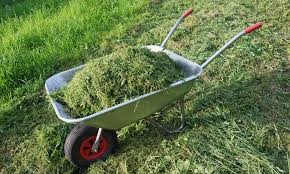

Grass clippings can be a great alternative to fertilizer! Fresh grass clippings used as mulch help to cool the root zone of the individual grass plants that comprise your lawn, they also help conserve moisture in soil underneath the lawn and can return lost nutrients to the soil. After the year’s first mow there can be a lot of clippings. If you mow your lawn correctly (or advise your landscaper) you should be using a clean, freshly sharpened mulching blade, set to a high height so only one third of the height of the grass is being cut at one time. This creates a fine spray of clippings, not a huge hay-like pile, and these tiny grass snips disappear into the lawn breaking down rapidly and feeding the lawn. (How to Mulch With Grass Clippings, Today’s Homeowner)
Grass clippings can also be mixed with mulched dried leaves and used as a garden bed mulch. Incorporating grass clippings into ornamental beds, adds valuable organic matter to soils, allowing for a higher concentration of water and air transport into the soil, allowing soils to hold moisture for longer. Try running over a pile of last year’s leaves and gras clippings with a mulching lawnmower with the blade set on high, then spread the resultant mulch mix around your ornamental beds. Cover with a fine layer of top-dressing mulch for a more polished appearance. (Mulching with Grass Clippings, GardenKnowHow)
3. “Fertilizer right before rainfall” It’s a myth!
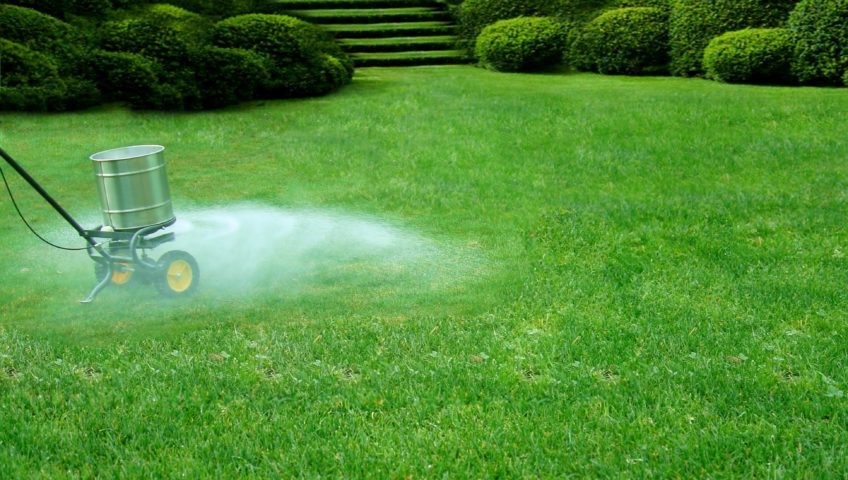
You wouldn’t throw money directly down the storm drain, why do the same with fertilizer?
Many people do it, but spreading fertilizer within 24 hours of predicted rainfall causes much of the applied fertilizer to simply wash away, and is a real waste. Many homeowners start their spring lawn care regimen by applying a general all-purpose fertilizer, or even a weed and feed, whether their soil needs it or not. However, over fertilizing, or application immediately before it rains often leads to fertilizer runoff during rainstorms into nearby bodies of water. This causes a water quality issue through excess nutrients fertilizing growth of algae within the streams and lakes that yard runoff enters. Following your soil test, purchase the fertilizer you need, but also apply it in the recommended method. Read the label. Here is some great advice on choosing the right fertilizer. (Free Lawncare Guides, The LawnCareNut) If you use a hand spreader, make sure it is set to dispense the correct amount and follow this great advice for good application. Finally, be a neat freak, sweep the edges of your lawn to remove excess granular fertilizer before it has a chance to run off in the next spring shower. (SLYT)
4.Mow higher
Keep the buzzcuts for your kid’s hair and allow your lawn to grow it out a little!
Leaving grass blade height longer confers many benefits to your lawn and your watershed! By keeping the grass on the longer side, there is more blade to photosynthesize- making more food for the grass plant and requiring fewer added nutrients. Taller grass height allows shading of the sensitive root area, reducing water loss and stress on the plant, especially during hot spells. Healthier roots absorb more water and reach deeper into the soil, reducing the amount of water needed during dry periods and requiring fewer pesticides. Cutting grass short also creates bare spots, allowing pesky weed seeds to gain a foothold. So, make scalping a thing of the past and raise that mower height! 3” or more is a great height to set your blade. (4 Reasons to Keep Your Lawn Short, The Spring Green)
5. Create a no mow zone
Consider creating buffer edges or no mow zones to protect delicate areas. No mow zones are especially effective on sloped lawns and lawns located near bodies of water, or along an area where sediment or salt might be a runoff issue. A no mow zone is simply an area of grass, shrubs, and groundcover that is allowed to grow out, being mowed only infrequently, typically two to three times a year. Taller grass height allows sheet runoff to be slowed, and non-point source pollutants to be effectively trapped, keeping them from water bodies.
No mow zones also allow for the recovery of native vegetation allowing for an increase in biodiversity. Consider leaving a 3foot wide strip along unseen portions of the yard, snip the weeds out of he grasses over the first few weeks and watch as many native plants will make an appearance, attracting beneficial pollinating species. No mow strips act as valuable buffers between the lawn and bodies of water, filtering pollutants and reducing soil erosion and salt deposition during storms.
6. Switch to low maintenance lawn alternatives
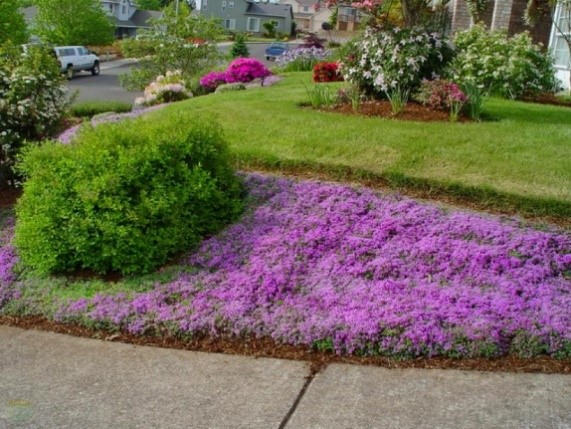

Try taking a portion of your lawn out of grass and into a groundcover but ensure it’s not an aggressive spreader or invasive plant . Many commercially available groundcovers are invasive, such as; vinca vine, English ivy and pachysandra. Some environmentally friendly landscape options include native groundcovers such as prairie dropseed, woodland ferns or creeping thyme. These options require very little maintenance and often no mowing, and act to suppress weeds and provide visual interest in a reduced lawnscape. There are several great resources to find the perfect plant to liven up your low maintenance yard. (Native Plant Picker, GrowNative.org)
By Chris Coultas, Nicky Vanech and Hazel England
Part of our Watershed Friendly Living Series. For more eco-friendly tips, visit our Watershed Friendly Living Page.
